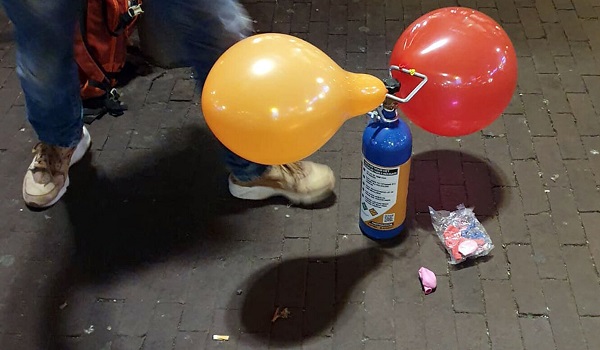
Buba Marwa, chairman of the National Drug Law Enforcement Agency (NDLEA), has ordered the arrest of sellers and users of nitrous oxide, otherwise known as “laughing gas”.
Femi Babafemi, NDLEA spokesperson, in a statement on Tuesday, said ‘laughing gas’ is fast becoming a drug in demand in Nigeria.
Babafemi said: “Nitrous oxide is a colourless gas that is commonly used for sedation and pain relief, more often by dentists and medical professionals to sedate patients undergoing minor medical procedures,” the statement reads.
“Popularly called laughing gas or N20, it is fast emerging as a drug in demand in Nigeria by young party-goers or fun-seekers to feel intoxicated or high.
“The gas is often transferred from its containers into balloons, from where it’s inhaled for euphoric effects.
“The decision to clampdown on those involved in the illegal sale and use of nitrous oxide follows an analysis of the effects on those who abuse the substance, which include: dizziness; disorientation, headache; lightheadedness; fainting spells; hallucinations; falling unconscious and/or suffocating from lack of oxygen; and other neurological complications, especially psychiatric symptoms.”
——ABC OF LAUGHING GAS
What To Know About Laughing Gas
Written by WebMD Editorial Contributors
Nitrous oxide slows down your brain and your body’s responses, and the effects of the drug varies depending on how much has been inhaled. Taking nitrous oxide can cause: feelings of euphoria, relaxation and calmness. fits of giggles and laughter – hence the nickname ‘laughing gas’
Nitrous oxide, commonly known as laughing gas or happy gas, is a colorless, non-flammable gas. This gas is used in medical and dental procedures as a sedative. It helps to relieve anxiety before the procedure and allow the patient to relax.
Nitrous oxide (N2O) is called “laughing gas” because it has a euphoric effect when inhaled.
How Is Laughing Gas Used?
Laughing gas is an anesthetic used by medical professionals to help you remain calm before a procedure. It’s not meant to put you fully to sleep.
Before your procedure, your doctor will ask you for your consent to use nitrous oxide. After that, a plastic mask will be placed over your mouth and nose. The laughing gas flows through the mask and you breathe it in.
Children may be given laughing gas through a nasal hood, which covers their nose but not their mouth. Sometimes, a familiar scent will be added in to help them get used to having the mask or nasal hood on.
You’ll start to feel the effects of the laughing gas within a few minutes. As laughing gas doesn’t put you fully to sleep, you’ll still be able to hear what’s going on around you. You may still be able to respond to questions that your doctor asks you and follow the instructions that they give you throughout the procedure.
Nitrous oxide is a depressant, so it slows your body down. Once it kicks in, you may feel:
· Happy
· Giggly
· Light-headed
· Mild euphoria
· Relaxed
Nitrous oxide gets the name “laughing gas” because of these effects. Some people may also experience mild hallucinations while under the use of laughing gas.
Physically, you might feel like your arms and legs are heavy. You may also experience a tingling sensation in your limbs.
Once your procedure is over, your doctor will remove the mask that’s providing the nitrous oxide. The effects of laughing gas typically wear off within a few minutes. Children might be given 100% oxygen following the removal of the nitrous oxide mask. The oxygen helps them to fully recover within minutes.
Possible Side Effects of Laughing Gas
Nitrous oxide is safe to use under the proper care of a doctor. However, some people may experience side effects either during or after use.
The most common side effects of laughing gas are headaches and nausea. Children may also feel agitated or might vomit after the laughing gas is removed. The good news is that only about 5% of patients experience these side effects.
There are no long-term side effects of nitrous oxide when it is only used occasionally. However, if you have to undergo multiple or frequent procedures that require using laughing gas, your doctor might recommend you take a B12 supplement. This is to help prevent anemia.
Risks of Using Laughing Gas
As mentioned, laughing gas is safe to use when it is given to you by a doctor and you are under medical care. However, there are several risks of using nitrous oxide when it is not given to you by a doctor.
When used as a recreational drug, nitrous oxide is usually dispensed into another object, like a bag or balloon, or directly into the mouth. Because of this, nitrous oxide is classified as an inhalant. Nitrous oxide can be found in the silver chargers that are used to make whipped cream. Recreational users inhale laughing gas for the euphoric effect.
Along with negative side effects, there are several risks of using laughing gas as a recreational drug, including:
· Lowering of blood pressure
· Fainting
· Heart attack
· Hypoxia, or the fatal loss of oxygen
· B12 deficiency and anemia
· Nerve damage due to the tingling sensation
Prolonged recreational use of nitrous oxide has several negative long-term effects, like:
· Memory loss
· Incontinence
· Depression
· Psychological dependence
· Psychosis
· Weak immune system
· Numbness in hands and feet
· Limb spasms
· Ringing in your ears
Another of the risks of using laughing gas is that it affects your coordination, like many other recreational drugs. This can be dangerous if nitrous oxide is used in a place where you could fall and hurt yourself or cause danger to others. It is also very dangerous to try to drive or operate machinery while under the effects of laughing gas.
Follow us on Facebook/ twitter














